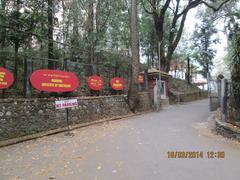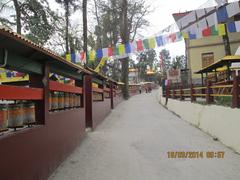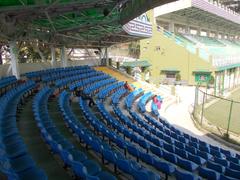
Comprehensive Guide to Visiting the Gangtok Ropeway, Sikkim, India
Date: 18/07/2024
Introduction
Gangtok, the capital city of Sikkim, India, is renowned for its pristine natural beauty, rich cultural heritage, and innovative infrastructure. One of the most iconic attractions in this city is the Gangtok Ropeway, also known as the Deorali Ropeway. Inaugurated on December 24, 2003, this bi-cable aerial tramway has become a symbol of Gangtok’s commitment to sustainable tourism and urban modernization. The idea for constructing the ropeway emerged in the late 1990s as a solution to the city’s traffic congestion and to provide an accessible mode of transportation for both locals and tourists. The project was executed by Damodar Ropeways and Infra Limited (DRIL), a company well-versed in ropeway construction and operations. With its panoramic views of the city and the Himalayan peaks, the Gangtok Ropeway offers a unique experience that combines convenience and breathtaking scenery. Visitors can enjoy a smooth ride over Gangtok’s lush valleys and iconic landmarks, making it a must-visit attraction for anyone traveling to this part of India (source).
Table of Contents
- Gangtok Ropeway - Visiting Hours, Tickets, and Historical Significance
- Gangtok Ropeway Guide - Visiting Hours, Ticket Prices, and Travel Tips
- Gangtok Ropeway Visitor Tips - Visiting Hours, Ticket Information, and Travel Tips
Gangtok Ropeway - Visiting Hours, Tickets, and Historical Significance
The Gangtok Ropeway, officially known as the Gangtok bi-cable aerial tramway, stands as a testament to the city’s commitment to sustainable tourism and innovative infrastructure.
Early Beginnings and Construction
The idea for a ropeway in Gangtok was conceived in the late 1990s as a solution to the city’s growing traffic congestion and the need to provide accessible transportation for both residents and tourists. The aim was to create a system that would not only alleviate traffic but also offer breathtaking views of the city and the surrounding Himalayan peaks.
The construction of the Gangtok Ropeway was a challenging feat of engineering, given the region’s mountainous terrain and unpredictable weather conditions. The project was undertaken by Damodar Ropeways and Infra Limited (DRIL), a company renowned for its expertise in ropeway construction and operation. The ropeway was built using a bi-cable system, known for its stability and safety, particularly in hilly regions.
Inauguration and Initial Impact
The Gangtok Ropeway was inaugurated on December 24, 2003, marking a significant milestone in the city’s development. The ropeway quickly gained popularity, attracting both domestic and international tourists eager to experience Gangtok from a unique perspective.
The ropeway’s impact extended beyond tourism. It provided a much-needed alternative mode of transportation for locals, connecting different parts of the city and reducing travel time significantly. This was particularly beneficial for residents of areas that were previously difficult to access by road.
Evolution and Modernization
Over the years, the Gangtok Ropeway has undergone several upgrades and renovations to enhance its safety, capacity, and overall visitor experience. These upgrades have included the introduction of new cabins with larger windows for panoramic views, improved safety features, and modernized ticketing systems.
The ropeway has also played a role in promoting environmental awareness. By offering an alternative to vehicular traffic, it has contributed to reducing air and noise pollution in the city, preserving the pristine beauty of the Himalayan region.
Visitor Information
**Visiting Hours - ** The Gangtok Ropeway operates daily from 9 - 30 AM to 4 - 30 PM, weather permitting. It is advisable to check for any changes in operating hours, especially during the monsoon season.
**Tickets - ** Tickets for the Gangtok Ropeway can be purchased at the lower station. Prices are typically around INR 110 for adults and INR 70 for children, though prices may vary. It’s recommended to buy tickets in advance during peak tourist seasons.
**Travel Tips - ** For the best experience, visit early in the morning or late in the afternoon to avoid crowds and enjoy the clearest views. Wear comfortable clothing and be prepared for sudden weather changes.
Cultural and Social Significance
The Gangtok Ropeway has become an integral part of the city’s identity, symbolizing progress, innovation, and the harmonious coexistence of modernization and nature. It has also created employment opportunities for locals, contributing to the economic development of the region.
The ropeway has become a popular spot for social gatherings and celebrations. Locals and tourists alike gather at the ropeway stations and during rides to enjoy the scenic beauty, capture memorable photographs, and share experiences.
Nearby Attractions and Accessibility
**Nearby Attractions - ** While visiting the Gangtok Ropeway, consider exploring other nearby attractions such as the Enchey Monastery, Ganesh Tok, and the Flower Exhibition Centre. These sites offer additional insights into Gangtok’s rich cultural heritage.
**Accessibility - ** The Gangtok Ropeway is accessible by taxi or local transport from various parts of the city. It is located near the Deorali Market, making it convenient for visitors to combine their trip with local shopping and dining.
Continued Relevance and Future Prospects
The Gangtok Ropeway continues to be a major tourist attraction and a vital mode of transportation in Gangtok. Its significance extends beyond its practical uses, representing the city’s commitment to sustainable development and providing a unique perspective on the region’s natural and cultural heritage.
As Gangtok continues to grow as a tourist destination, the ropeway is expected to play an even more crucial role in the city’s transportation infrastructure. Future plans may include expanding the ropeway network to connect more areas of the city and further enhance its accessibility and convenience for both residents and visitors.
FAQs
Q - What are the Gangtok Ropeway visiting hours? A - The ropeway operates daily from 9 - 30 AM to 4 - 30 PM, weather permitting.
Q - How much are the tickets for the Gangtok Ropeway? A - Ticket prices are typically around INR 110 for adults and INR 70 for children.
Q - Are there any nearby attractions to visit? A - Yes, nearby attractions include the Enchey Monastery, Ganesh Tok, and the Flower Exhibition Centre.
Q - How can I get to the Gangtok Ropeway? A - The ropeway is accessible by taxi or local transport and is located near the Deorali Market.
For more updates and information, download the Audiala mobile app or follow us on social media.
Gangtok Ropeway Guide - Visiting Hours, Ticket Prices, and Travel Tips
The Gangtok Ropeway is a must-do activity for anyone visiting Gangtok, Sikkim. It offers breathtaking views of the city, the surrounding mountains, and the majestic Kanchenjunga range. Here’s everything you need to know about experiencing this engineering marvel -
Location
The Gangtok Ropeway, officially known as the Deorali Ropeway, is conveniently located in the heart of Gangtok city.
- **Starting Point - ** The lower terminal of the ropeway is situated near the Sikkim Tourism office in Deorali Bazaar, a bustling market area.
- **Accessibility - ** The base station is easily accessible by road and is well-connected to other parts of Gangtok. Taxis and local buses are readily available.
Timings
The Gangtok Ropeway operates throughout the week, offering rides from late morning to late afternoon. However, the timings may vary slightly depending on the season and weather conditions.
- **Daily Operations - ** 9 - 30 AM to 4 - 30 PM
- **Holiday Operations - ** The ropeway generally operates on public holidays as well. However, it’s always a good idea to check for any special announcements or changes in timings.
Tickets
Tickets for the Gangtok Ropeway can be purchased directly at the ticket counter located at the lower terminal. It’s advisable to arrive early, especially during peak tourist season, to avoid long queues.
- **Ticket Price - ** INR 130 per person for a round trip.
- **Payment Methods - ** Cash and card payments are usually accepted. However, it’s best to confirm the accepted payment methods beforehand.
- **Discounts - ** Discounts may be available for children, students, or senior citizens. It’s recommended to inquire about potential discounts at the ticket counter.
Making the Most of Your Ropeway Experience
- **Best Time to Visit - ** For optimal visibility and stunning views, aim to ride the ropeway on a clear day. The early morning or late afternoon hours often offer pleasant weather and fewer crowds.
- **Photography Tips - ** The cable car provides ample opportunities for capturing panoramic photographs. Keep your camera ready to capture the beauty of the snow-capped Himalayas, lush valleys, and the sprawling city below.
- **Duration of the Ride - ** The ropeway ride covers a distance of approximately one kilometer and takes around 7-8 minutes for a one-way trip. The entire round trip, including brief stops at the two intermediate stations, takes about 20-25 minutes.
- **What to Wear - ** Comfortable clothing and footwear are recommended. As the cable car ascends, the temperature might drop slightly, so carrying a light jacket is advisable.
Beyond the Ride - Exploring the Stations
The Gangtok Ropeway doesn’t just offer a thrilling ride; each of its three stations presents unique experiences -
- **Lower Terminal (Deorali Bazaar) - ** Before embarking on your ropeway journey, take some time to explore the vibrant Deorali Bazaar. This bustling market is a great place to find local handicrafts, souvenirs, and traditional Sikkimese attire.
- **Intermediate Station 1 - ** This station offers a closer look at the lush greenery and the city’s architecture. You can disembark here for a short break, take a stroll, and enjoy the views from a different vantage point.
- **Intermediate Station 2 - ** This station provides access to a small park and a cafeteria. It’s an ideal spot to relax, grab a quick bite, and soak in the serene ambiance.
- **Upper Terminal (Tsuklakhang Monastery) - ** The upper terminal is located near the Tsuklakhang Monastery, an important religious site for Buddhists. You can visit the monastery, learn about its history, and witness the monks’ daily rituals.
Nearby Attractions
- **MG Marg - ** A popular pedestrian-only street known for shopping and dining.
- **Enchey Monastery - ** A serene monastery offering spiritual solace and beautiful views.
- **Tsomgo Lake - ** A glacial lake around 40 km from Gangtok, known for its scenic beauty.
Important Considerations
- **Weather Dependence - ** The ropeway operation is subject to weather conditions. In case of heavy rain, snowfall, or strong winds, the service might be temporarily suspended for safety reasons.
- **Accessibility - ** While the ropeway itself is accessible to people with disabilities, access to certain areas within the stations might be limited. It’s advisable to inquire about accessibility provisions beforehand.
- **Respectful Conduct - ** As with any tourist destination, maintaining respectful conduct and adhering to local customs is essential. Dress modestly when visiting religious sites and be mindful of noise levels.
FAQ
- **Q - ** What are the Gangtok Ropeway visiting hours?
- **A - ** The ropeway operates daily from 9 - 30 AM to 4 - 30 PM.
- **Q - ** How much are the Gangtok Ropeway tickets?
- **A - ** Tickets are priced at INR 130 per person for a round trip.
- **Q - ** Are there any discounts on the Gangtok Ropeway tickets?
- **A - ** Discounts may be available for children, students, and senior citizens. Please inquire at the ticket counter for the latest offers.
- **Q - ** Is the Gangtok Ropeway accessible for people with disabilities?
- **A - ** The ropeway is accessible, but certain station areas might have limited accessibility. Inquire beforehand.
Plan Your Visit
The Gangtok Ropeway is not just a mode of transportation; it’s an experience that encapsulates the beauty, spirituality, and charm of Gangtok. By keeping these tips in mind, you can ensure a memorable and enjoyable ropeway adventure.
Gangtok Ropeway Visitor Tips - Visiting Hours, Ticket Information, and Travel Tips
Introduction
Discover the breathtaking views of Gangtok and the surrounding Himalayan peaks by taking a ride on the Gangtok Ropeway. This guide covers everything you need to know—from visiting hours and ticket information to travel tips and more—to ensure you make the most of your experience.
Planning Your Visit
- **Best Time to Visit - ** The ropeway operates throughout the year, but the best time to visit is during the clear skies of the shoulder seasons (March-May and September-November) for optimal views.
- **Gangtok Ropeway Visiting Hours - ** The ropeway is open daily from 9 - 30 AM to 4 - 30 PM. Check for any seasonal variations or closures before planning your visit.
- **Check the Weather - ** Clear weather is essential for enjoying the panoramic views. Check the weather forecast before your visit and try to go on a sunny day. Reliable weather forecasts can be found [here](https - //www.weather.com/).
- **Arrive Early - ** The ropeway tends to get crowded, especially during peak tourist season. Arriving early in the morning can help you avoid long queues.
- **Gangtok Ropeway Tickets - ** Tickets can be purchased at the ropeway station. Consider purchasing tickets online in advance, especially during peak season, to save time. The ticket price is INR 130 for adults. For more details, visit the [official Gangtok Ropeway website](http - //www.gangtokropeway.com).
- **Photography - ** Photography is allowed and encouraged! Capture the stunning vistas of Gangtok and the surrounding Himalayan peaks.
During Your Ride
- **Choose Your Cabin Wisely - ** Opt for a cabin at the front or rear for unobstructed views.
- **Duration - ** The ropeway ride is a leisurely 1 km loop, offering ample time to soak in the scenery.
- **Look Out for Landmarks - ** As you ascend, try to spot prominent landmarks like the Tashiding Monastery, Rumtek Monastery, and the majestic Kanchenjunga range.
- **Listen for Announcements - ** Pay attention to announcements made in English and Hindi, providing insights into the sights below.
Enhancing Your Experience
- **Combine with a Visit to Tashi View Point - ** The Gangtok Ropeway is located near the Tashi View Point, another popular spot for panoramic views. Consider combining both attractions for a comprehensive experience.
- **Carry Water and Snacks - ** While there are shops near the ropeway station, it’s advisable to carry water and snacks, especially if you plan to spend time at the viewpoints.
- **Dress Comfortably - ** Wear comfortable shoes and clothing, as you might do some walking at the viewpoints.
- **Respect Local Culture - ** Gangtok is a city with strong Buddhist traditions. Dress modestly and be mindful of local customs and beliefs.
Accessibility
- **Wheelchair Accessibility - ** The ropeway is wheelchair accessible, making it a convenient option for visitors with mobility issues.
- **Restrooms - ** Public restrooms are available at the ropeway station.
Additional Tips
- **Keep Your Belongings Safe - ** Be mindful of your belongings, especially in crowded areas.
- **Stay Hydrated - ** Drink plenty of water, especially at higher altitudes.
- **Protect Yourself from the Sun - ** Wear sunscreen, sunglasses, and a hat, as the sun can be strong at higher altitudes.
- **Respect the Environment - ** Refrain from littering and help preserve the natural beauty of the surroundings.
FAQ Section
- What are the Gangtok Ropeway visiting hours? The ropeway is open daily from 9 - 30 AM to 4 - 30 PM.
- How much are the tickets for the Gangtok Ropeway? Ticket prices are INR 130 for adults.
- Is the Gangtok Ropeway wheelchair accessible? Yes, the ropeway is wheelchair accessible.
Historical Background and Cultural Significance
The Gangtok Ropeway is not just a marvel of modern engineering but also a window into the rich cultural landscape of Sikkim. The ropeway offers views of significant historical sites like the Tashiding and Rumtek Monasteries, which are important spiritual centers in the region. These sites offer a glimpse into the Buddhist traditions that have shaped the local culture.
By following these tips, you can make the most of your visit to the Gangtok Ropeway and create unforgettable memories of your time in Sikkim. For more travel tips and updates, download our mobile app Audiala and follow us on social media.
Conclusion
The Gangtok Ropeway stands as a remarkable example of how modern engineering can coexist harmoniously with nature and tradition. Since its inauguration in 2003, it has not only served as a vital mode of transportation but also as a major tourist attraction, offering unparalleled views of Gangtok and the surrounding Himalayan peaks. Over the years, the ropeway has undergone several upgrades to enhance its safety, capacity, and visitor experience, reinforcing its role in promoting sustainable tourism and reducing vehicular pollution in the city. With its strategic location near various cultural and natural landmarks, the Gangtok Ropeway continues to attract visitors from around the world, contributing significantly to the local economy and cultural preservation. As Gangtok continues to grow as a tourist destination, the ropeway is expected to play an even more crucial role in the city’s transportation infrastructure, potentially expanding to connect more areas and provide greater accessibility for both residents and visitors. For an unforgettable experience that encapsulates the beauty, spirituality, and innovation of Gangtok, a ride on the Gangtok Ropeway is a must (source).




